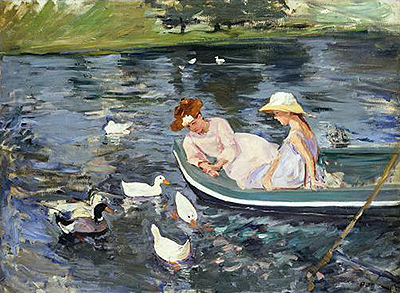Summertime feels distinctly Impressionist, from the loose brushwork and the bright palette to the content involved, which is a riverside theme from the late 19th century. This was an important period in European society when many residents were starting to enjoy free time at the weekends.
It was 1894 and Cassatt decided to produce several artworks whilst sat besides a calm river in France. She would already have seen many different interpretations on similar content within the Impressionist movement and so perhaps was inspired to add her own contributions to this genre. In this example she works loosely and without too much desire to soften brushstrokes, making it something of a study in oils, which was an excellent way of preparing for a later, more complete oil painting. We find two young women sat in a small boat which has been accompanied by a group of white ducks. They are perhaps feeding them with some spare bread, whilst generally relaxing in this picturesque location. At the far end of the painting we can see a grassy bank with several trees added roughly. The river is constructed from a number of horizontal lines of paint which in some cases are not blended together, giving the impression of an oil painting in its very early stages.
Cassatt takes some of the tones from the content in this artwork and then repeats them in various parts of the river, essentially providing the feeling of reflection. For example, the white and pink tones of the ladies' outfits are then seen again in single dabs of paint which are evenly added across the river. There is also a variation in the tones of blue used across the river in order to give the impression of some gentle waves, partly caused by the excited ducks who are searching for food. The boat itself would also have made an impact here, but the artist wants to provide an overall atmosphere of serenity, rather than turbulent waves. River boat trips were very common during the late 19th century, as we were many years before the rise of technology within leisure time, and many could not afford to travel too far from their homes and would therefore make use of the local environment much more often than we might do today.
Mary Cassatt would produce a similar work in the same year, probably in the same month, but that composition was cropped down to just include the women in the boat and a few surrounding ducks. That version can be found in the Daniel J. Terra Collection which specialises in American art, but often with artists who also displayed influences from European art. John Singleton Copley, Thomas Moran, George Inness and Thomas Hart Benton are just some of the names to be found within their impressive selection of art though the foundation also provides other art-related services besides just displaying these artworks. They also have a number of other items from Cassatt's career and today their overall collection of art would be worth many, many millions of dollars.




